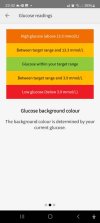MarthaD
Well-Known Member
I'm not yet formally diagnosed with RH, but currently having tests for my hypos. Meanwhile, I've a question about the libre 2 and how it records hypos. I had very bad hypo symptoms the other day that took me a while to come out of. While I was experiencing the symptoms, my libre 2 wavered between 3.9 and 3.8. This continue for about 20 minutes. I couldn't do a finger prick at the time, but I think if I had it would have confirmed the hypo and I might even have read lower than 3.8 (I find the libre sometimes will say 4.1 when a finger prick reads at 3.6, for example). The problem I have is that I'm wearing a libre 2 so I can demonstrate to the endo that I'm having hypos, but it rarely registers them on the app as a low glucose event. In this particular case it shows a very rapid decline from 11mmol to about 4mmol, but the hypo itself didn't register, despite reading under 3.9 for ages. This has happened to me loads of time and so it's very difficult to "prove" my hypos through the libre, even when I'm very symptomatic and finger prick confirms. Has anyone else experienced this?






